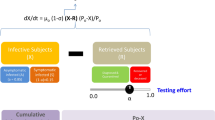Abstract
The transmission of COVID-19 through a population depends on many factors which model, incorporate, and integrate many heterogeneous data sources. The work we describe in this paper focuses on the data management aspect of EpiGraph, a scalable agent-based virus-propagation simulator. We describe the data acquisition and pre-processing tasks that are necessary to map the data to the different models implemented in EpiGraph in a way that is efficient and comprehensible. We also report on post-processing, analysis, and visualization of the outputs, tasks that are fundamental to make the simulation results useful for the final users. Our simulator captures complex interactions between social processes, virus characteristics, travel patterns, climate, vaccination, and non-pharmaceutical interventions. We end by demonstrating the entire pipeline with one evaluation for Spain for the third COVID wave starting on December 27th of 2020.
This work has been supported by the Spanish Instituto de Salud Carlos III under the project grant 2020/00183/001, the project grant BCV-2021-1-0011, of the Spanish Supercomputing Network (RES) and the European Union’s Horizon 2020 JTI-EuroHPC research and innovation program under grant agreement No. 956748. We would like to thank to Diego Fernandez Olombrada for his support in the early collection of part of the data of this work.
Access this chapter
Tax calculation will be finalised at checkout
Purchases are for personal use only
Similar content being viewed by others
Notes
- 1.
Note the EpiGraph employs static and dynamic contact patterns, and in this section we are referring to the static one.
- 2.
Note that each collective and sub-collective has different group sized based on the activity that they perform.
- 3.
Note that the vaccination prioritization strategy is similar for all European countries.
References
AEMET: Agencia estatal de meteorología (aemet) (2021). https://www.aemet.es
Batra, S.: Facebook data (2018). https://www.kaggle.com/sheenabatra/facebook-data
Brauer, F., Castillo-Chavez, C.: Mathematical Models in Population Biology and Epidemiology. Springer, New York (2012). https://doi.org/10.1007/978-1-4614-1686-9
Carcione, J.M., Santos, J.E., Bagaini, C., Ba, J.: A simulation of a COVID-19 epidemic based on a deterministic SEIR model. Front. Public Health 8, 1–13 (2020)
Castro, L., Fairchild, G., Michaud, I., Osthus, D.: COFFEE: COVID-19 Forecasts using Fast Evaluations and Estimation. Los Alamos National Laboratory, LA-UR-20-28630 (2020)
Chinazzi, M., Mistry, D.: Mixing patterns (2021). https://github.com/mobs-lab/mixing-patterns
Cukierski, W.: The Enron email dataset (2015). https://www.kaggle.com/wcukierski/enron-email-dataset
The European Centre for Disease Prevention and Control: Updated projections of COVID-19 in the EU/EEA and the UK. Technical report, ECDC, Stockholm (2020)
European Centre for Disease Prevention and Control (ECDC): Home-ECDE (2021). https://www.ecdc.europa.eu/en
European Commission (EC - DG ESTAT): HappyGISCO Python interface to GISCO web-services (2021). https://happygisco.readthedocs.io/en/latest/
Eurostat: Home-Eurostat (2021). https://ec.europa.eu/eurostat
Flaxman, S., et al.: Estimating the effects of non-pharmaceutical interventions on COVID-19 in Europe. Nature 584, 257–261 (2020)
Flaxman, S., Mishra, S., et al.: Estimating the number of infections and the impact of non-pharmaceutical interventions on COVID-19 in European countries: technical description update. arXiv:2004.11342 (2020)
Grazzini J., Museux J.-M., Hahn M.: Eurostat (2021). https://ec.europa.eu/eurostat/web/nuts/background
Gu, Y.: COVID-19 projections using machine learning (2020). https://covid19-projections.com
Guzmán-Merino, M., et al.: Assessing population-sampling strategies for reducing the COVID-19 incidence. Preprint (2021)
Li, M.L., et al.: Overview of DELPHI Model V3 - COVID Analytics (2020)
Lovasz, L.: Random walks on graphs: a survey. Bolyai Soc. Math. Stud. 2, 46 (1993). https://web.cs.elte.hu/~lovasz/erdos.pdf
Ministry of Economic Affairs and Digital Transformation (MINECO): National Statistics Institute (INE) (2021). http://www.ine.es
Rostami, A., et al.: First “snap-shot’’ meta-analysis to estimate the prevalence of serum antibodies to SARS-CoV-2 in humans. Clin. Microbiol. Infect. 27(3), 331–340 (2021)
Shah, A.S.V., et al.: Risk of hospital admission with coronavirus disease 2019 in healthcare workers and their households: nationwide linkage cohort study. BMJ 371 (2020). https://doi.org/10.1136/bmj.m3582
Singh, D.E., Marinescu, M.C., Carretero, J., Delgado-Sanz, C., Gomez-Barroso, D., Larrauri, A.: Evaluating the impact of the weather conditions on the influenza propagation. BMC Infect. Dis. 20, 265 (2020)
Singh, D.E., et al.: Evaluation of vaccination strategies for Spain. Preprint (2021)
Singh, D.E., et al.: Simulation of COVID-19 propagation scenarios in the Madrid metropolitan area. Front. Public Health 9, 172 (2021). https://doi.org/10.3389/fpubh.2021.636023
Author information
Authors and Affiliations
Corresponding author
Editor information
Editors and Affiliations
Rights and permissions
Copyright information
© 2022 Springer Nature Switzerland AG
About this paper
Cite this paper
Guzmán-Merino, M. et al. (2022). Data Management in EpiGraph COVID-19 Epidemic Simulator. In: Chaves, R., et al. Euro-Par 2021: Parallel Processing Workshops. Euro-Par 2021. Lecture Notes in Computer Science, vol 13098. Springer, Cham. https://doi.org/10.1007/978-3-031-06156-1_22
Download citation
DOI: https://doi.org/10.1007/978-3-031-06156-1_22
Published:
Publisher Name: Springer, Cham
Print ISBN: 978-3-031-06155-4
Online ISBN: 978-3-031-06156-1
eBook Packages: Computer ScienceComputer Science (R0)




